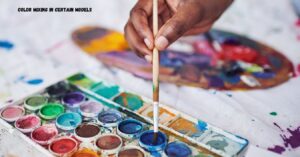What Two Colors Make Red: Know that you cannot make red. Red is a primary color, so you cannot create it by mixing any other colors. Primary colors are colors that exist on their own and do not contain traces of any other color. Aside from red, the other primary colors are blue and yellow.
key takeways
- Essential Color: Ruddy is a essential color in both the added substance (light) and subtractive (paint) color systems.
- No Blending Required: You cannot make ruddy by blending other colors; it is a base color.
- Creating Varieties: Whereas you can’t make ruddy from other colors, you can make varieties of ruddy by blending it with other colors. For example:
Red + Yellow = Orange–red
Red + Blue = Purple-red
Color mixing in certain models

When talking about color reproduction, it is important to distinguish between additive and subtractive color mixing models.
- Additional Color Blending: This is applied to show lighting. In this framework, the essential colors are red, green, and blue (RGB). When you mix these colors of light, you create complementary colors and eventually white light. For occasion, red and green light combine to provide yellow light.
- Subtractive Color Blending: This demonstration applies to colors and shades. In this framework, the essential colors are cyan, maroon and yellow (CMY). Mixing these colors results in complementary colors and when all are mixed together, it is dark in the long run. Red is an essential color in this show and cannot be mixed with other colors.
Part of colors and shades
In crafting and planning we use colors and shades to create color. Reds are an important ingredient and are used exclusively or perhaps more than they are made. For occasion, in photography, you’ll use a red dye straight from the tube, such as cadmium red or alizarin blood red.
How are colors perceived?
Effect of light on color perception

The way we see colors can be affected by various variables including lighting conditions. Certain light sources can change the appearance of colors, which can lead to confusion about how colors are mixed. For example, under yellow light, red may appear in a more unpredictable way than under characteristic light.
Color hypothesis in advanced media
In modern media, colors are created using the RGB display, where colors are created by mixing red, green, and blue light. On screens, you won’t find the combination of two colors that makes red. Instep, ruddy is an essential color, as in the traditional color hypothesis.
FAQs What Two Colors Make Red?
Can I mix colors to make red?
No, you cannot mix two colors to make red. Rudy is an essential color in both the traditional color wheel and the RGB show, meaning it cannot be formed by mixing other colors.
What colors do I need to mix to get red?
Red is an essential color in the mixing of secondary colors (colors and hues), so it does not need to be mixed. If you are using colors, you can use a particular shade of red without mixing.
What are the essential colors?
Primary colors are colors that cannot be made by mixing other colors. In the traditional color hypothesis, the essential colors are red, blue, and yellow. In computerized color blending (RGB demonstrated), the essential colors are red, green, and blue.
How does the color of the added substance contrast with the submodel?
The color show of added substances includes mixed light (RGB), where red, green, and blue light mix to create different colors, white counts. A subtractive color show includes mixed colors or colors (CMY), where mixing shades of cyan, maroon, and yellow fall into the color extension, counting black.
Why does Rudy look special under different lights?
The appearance of red can change depending on the lighting conditions. Certain light sources can change the perception of red, making it appear brighter, darker, or actually slightly different in tone.
Conclusion
Understanding what two colors make ruddy includes recognizing that ruddy is an essential color and cannot be made by blending other colors. In the domain of color hypothesis, ruddy stands as a crucial tint in both the added substance and subtractive color models. By getting a handle on these concepts, you pick up a clearer understanding of how colors are connected and can way better appreciate the complexity of color blending in different media

